Click image for BBB rating
See our Privacy Policy
Welcome to Spaightwood Galleries, Inc.
120 Main Street, Upton MA 01568-6193
You can follow us on Facebook and Twitter!
We blog regularly on Facebook and announce special events and special sales on both sites.
Käthe Kollwitz (German, 1867-1945): The Revolt of the Weavers
|
|
|
|
In The Revolt of the Weavers and in simlar works, Kollwitz explores one of the themes that interested her most, the desire of the oppressed and the powerless for freedom. The final version of the series consists of 3 lithographs and 3 etchings. We do not have the two of the three lithographs, though we do have the etched version of the third of the three. To these we have added a piece that Kollwitz had originally designed as the concluding plate, a symbolic summation of the whole series and its depiction of the fate of the suffering people, Aus vielen wounden blutest du, O volk / From how many wounds you bleed, oh my people! Finally we show here another etching which is both a restatement of the themes of The Revolt of the Weavers and a transitional piece (executed in 1899) en route to the larger scale images of her next major series, The Peasants' War, Aufruhr / Revolt!
|
|
|
|
|
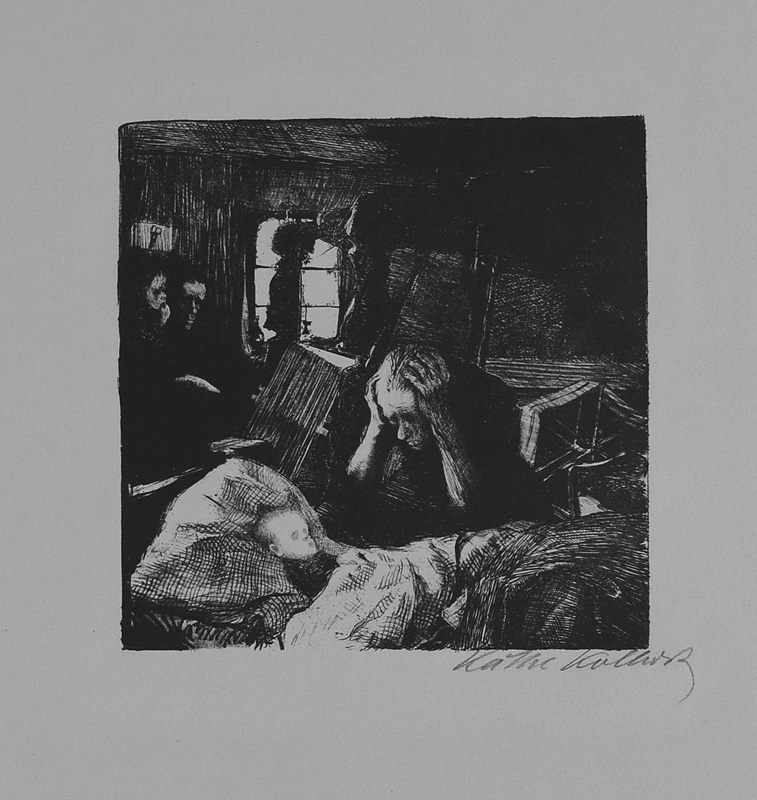 |
|
|
Not / Need (Kl. 34, von Knesebeck 33 A.III.c / B). Original lithograph, between 1893 and 1897). This is the first plate in The Weavers' Revolt). In A.I and A.II, Kollwitz was still working on the image and only proofs exist; in both cases, there are two vertical marks in the upper right corner. In 1918, Kollwitz published an edition of 50 signed proofs in brown on brown-yellow China mounted on copperplate paper. Ours is a signed proof printed on brownish machine-made paper in 1921 by Richter (who also printed the 1918 edition). Some of these proofs were signed; others were not. Ours is one of the signed impressions. A mother sits grieving over her dead or dying child. In the shadows on the left side, a girl and an older man (sister and father?) sit in a state of shock. Image size: 154x153mm. Price: Please call or email for current pricing information.
|
|
|
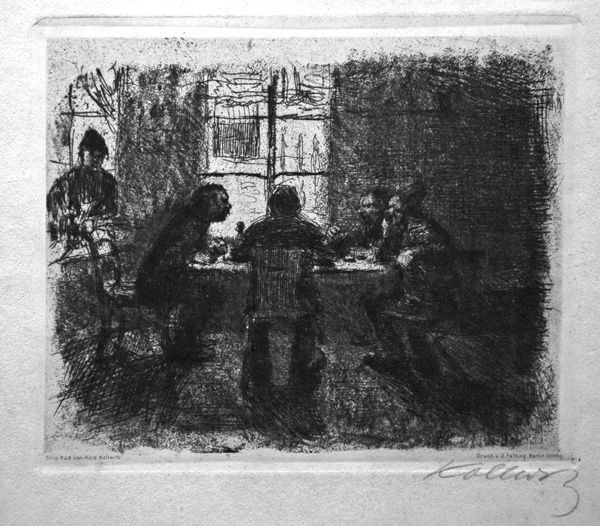 |
|
|
Vier manner in der kniepe / Four men in a pub (Kl. 12, von Knesebeck 15 II/III). Original soft-ground etching and aquatint, 1892-93. Edition: from the edition of unknown size published in 1921. Ours is a proof from the second state with the engraved text lower left "Orig. Rad. von Käte Kollwitz" and the information about the printer lower right (Druck von O. Felsing Berlin-Chittberg"), but before the publisher's information in the center: "VERLAG VON EMIL RICHTER, DRESDEN." Kollwitz here captures the conspiratorial and oppressive atmosphere of the German Empire in the late 19th century. This work, while not part of the series, shows Kollwitz already thinking about the themes to be explored in it and could be, von Knesebeck suggests, an early version of Beratung / Conspiracy. Image size: 125x150mm. Price: SOLD.
|
|
|
|
|
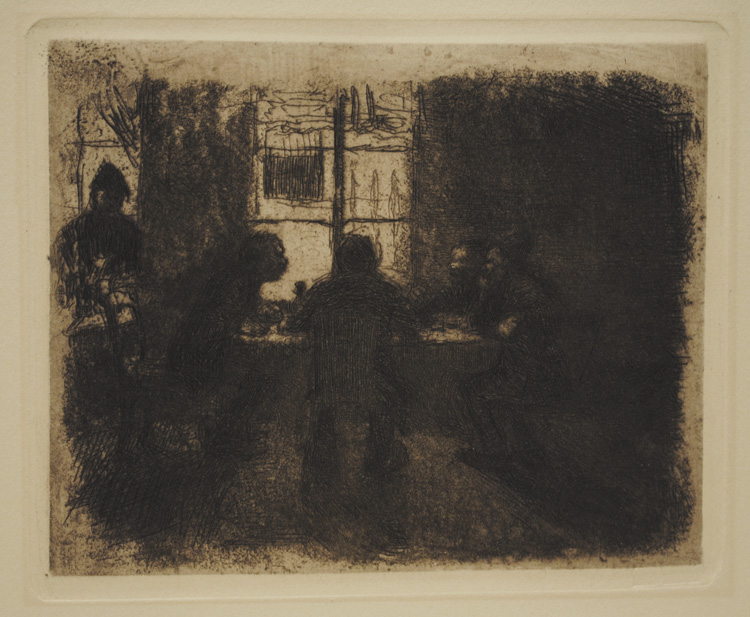 |
|
|
Vier manner in der kniepe / Four men in a pub (Kl. 12 iiib, Knesebeck III c). Original soft-ground etching and aquatint, 1892-93. Our impression is from one of the editions between 1946/48 and 1963/65, in brown or brown-violet, on various papers, among which lightly yellow or yellow-brown imitation Japan, later on thick, soft velin, some with von der Becke’s stamp of the artist’s signature and/or with von der Becke’s three-line Berlin-Halensee embossed seal. Ours has the three -line Berlin-Hamensee seal lower right. Kollwitz here captures the conspiratorial and oppressive atmosphere of the German Empire in the late 19th century. This work, while not part of the series, shows Kollwitz already thinking about the themes to be explored in it and could be, von Knesebeck suggests, an early version of Beratung / Conspiracy. Image size: 125x150mm. Price: Please call or email for current pricing information.
|
|
|
|
|
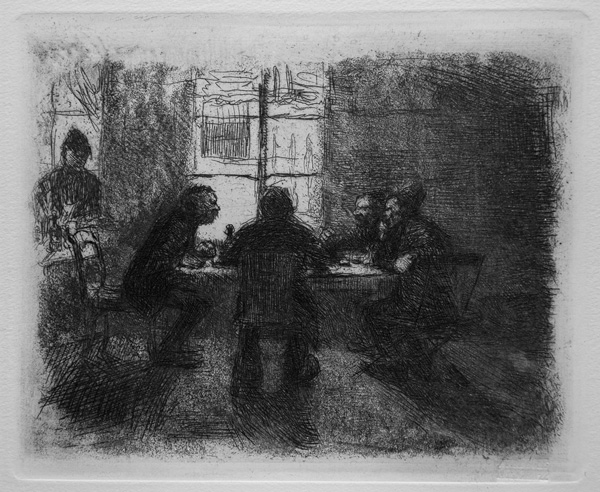 |
|
|
|
Vier manner in der kniepe / Four men in a pub (Kl. 12 iii d, Knesebeck III d). Original soft-ground etching and aquatint, 1892-93. Our impression is from one of the editions between 1963/65 and 1972, in brown or brown-violet, on thick, soft velin, with von der Becke’s Munich embossed seal. Kollwitz here captures the conspiratorial and oppressive atmosphere of the German Empire in the late 19th century. This work, while not part of the series, shows Kollwitz already thinking about the themes to be explored in it and could be, von Knesebeck suggests, an early version of Beratung / Conspiracy. Image size: 125x150mm. Price: Please call or email for current pricing information.
|
|
|
|
|
|
|
|
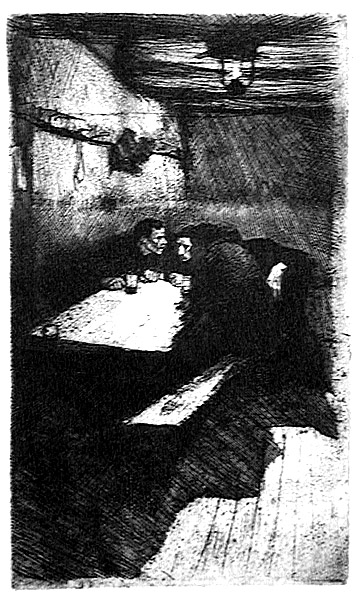 |
|
Beratung / Conspiracy (Kl. 25 vii / vii). Original etching, 1895. Edition: The first version of Conspiracy (plate 3 ) of the Weavers' Revolt. The final version was done in lithography (see below). Our impression is from the 1945 von der Becke edition with the blindstamp. The cycle so infuriated Kaiser Wilhelm that he refused to let Kollwitz go to Paris to accept the Prix de Rome. Image size: 296x178mm. Price: SOLD
|
|
|
|
|
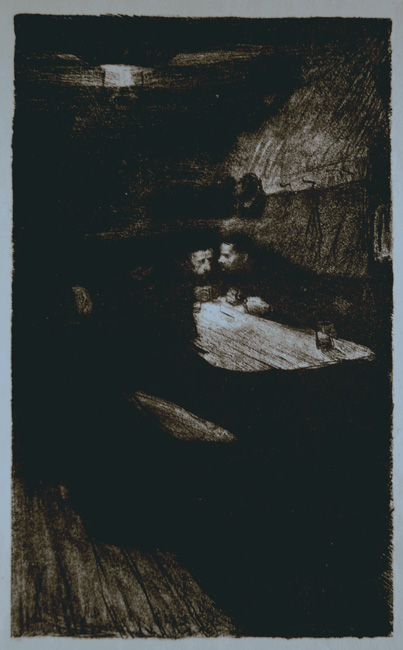 |
|
Beratung / Conspiracy (Kl. 31, von Knesebeck 35:B). Original lithograph printed in very very dark brown ink with scratch technique, 1893-97. Edition: Plate 3 in the Weaver's Revolt Cycle. Proofs before 1907, 2 Richter editions in 1918 (50 signed and numbered impressions) and 1921 (mostly unsigned impressions); transferred to a new stone after damage to the original and printed in unsigned impressions by von der Becke before 1931, of which ours is one. Kollwitz made three versions of this work, the first two as etchings; this final one via lithography, which allowed her to create the illusion of a dark smoky room in which no one can be seen clearly. The cycle so infuriated Kaiser Wilhelm that he refused to let Kollwitz go to Paris to accept the Prix de Rome. Image size: 2774x168mm. Price: Please call or email for current pricing information.
PS In the scratch technique (or "tampon sec"), the artist inks the stone, draws directly upon the stone with a sharp pointed object, and prints directly from the stone by rubbing the back of the paper as it presses on the stone; the places where she drew show up on the paper as white lines.
|
|
|
|
 |
|
|
Weberzug / The March of the Weavers (Kl. 32 iii/iii). Original etching and sandpaper aquatint, 1897. From the von der Becke edition after 1931 with the publisher's drystamp. Fine impression on wove paper printed in brown ink; repaired tear lower right corner extending into the bottom of the striding man's pants. Plate 4 of The Revolt of the Weavers. This is one of Kollwitz' most frequently illustrated prints. Image size: 214x297mm. Price: Please call or email for current pricing information.
|
|
|
|
|
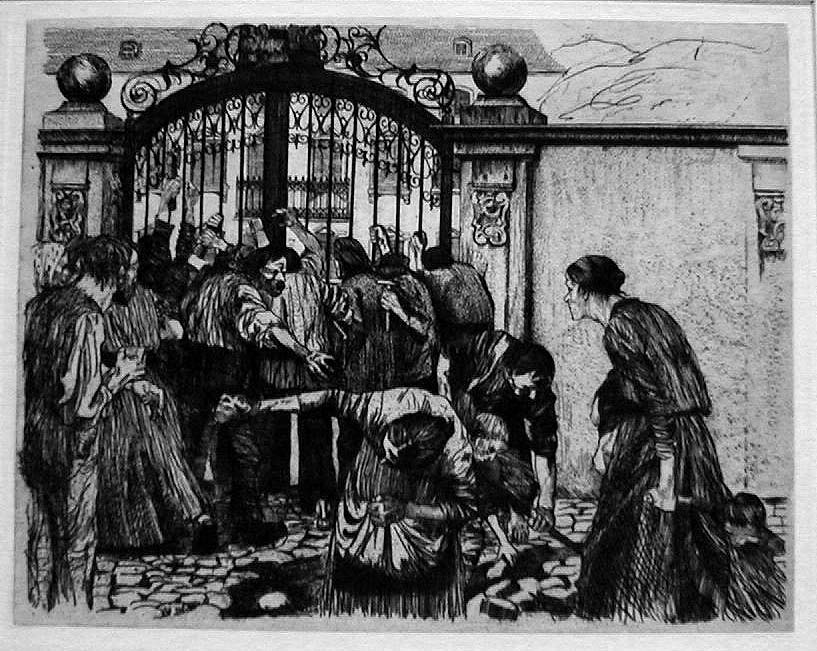 |
|
|
|
Sturm / Riot (Kl. 33 vb). Original etching and mezzotint, 1897. From the von der Becke edition with the publisher's drystamp. A good impression on wove paper from early in the print run. This is plate 5 of The Revolt of the Weavers. Illustrated Hinz, pl. 13; Zigrosser, pl. 7; Klein, p. 35; and Schmalebach, p. 16. One of Kollwitz' most frequently illustrated prints. Image size: 241x304mm. Price: SOLD.
|
|
|
|
|
 |
|
|
Sturm / Riot (Kl. 33 vb). Original etching and mezzotint, 1897. From the von der Becke edition with the publisher's drystamp. A fair impression on wove paper from later in the print run. THis is plate 5 of The Revolt of the Weavers. Illustrated Hinz, pl. 13; Zigrosser, pl. 7; Klein, p. 35; and Schmalebach, pk. 16. One of Kollwitz' most frequently illustrated prints. Image size: 241x304mm. Price: Please call or email for current pricing information.
|
|
|
|
|
 |
|
|
Ende / The End (Kl. 37 v/v). Original etching, aquatint, and sandpaper ground, 1897. Our impression is from one of the editions between 1963/65 and 1972, in brown or brown-violet, on thick, soft velin, with von der Becke’s Munich embossed seal. A fine impression on wove paper printed in black-purple ink. This is plate 5 of The Revolt of the Weavers. Illustrated Hinz, pl. 13; Zigrosser, pl. 7; Klein, p. 35; and Schmalebach, pl. 16. One of Kollwitz' most frequently illustrated prints. Image size: 241x304mm. Price: Please call or email for current pricing information.
|
|
|
|
|
 |
|
|
Aus vielen wounden blutest du, O volk / From many wounds you bleed, oh people! (Kl. 29 vb, Knesebeck 32 IVd). Original etching, drypoint, aquatint, and burnisher, 1893-1897. Printed by von der Becke between 1963/65 and 1972 in brown-violet on soft thick vellum with his 2-line Munich drystamp. Originally intended as an allegorical commentary upon The Revolt of the Weavers, the work was released separately. The title is etched at the top of the work. Image size: 129x335mm. Price: Please call or email for current pricing information.
|
|
|
|
|
 |
|
|
|
Zertretene / The Downtrodden (Kl. 42, Knesebeck 49 IV). Original etching, drypoint, aquatint, and burnisher, c. 1900. This is an impression of the right side of the plate after it was split into two etchings, each printed separately thereafter. Our impression published by Von Der Becke and inscribed with only the last line of his two-line drystamp in the lower right corner just above the platemark, "Muenchen 22." The print is a symbolic depiction of the terrible plight of the poor. The dead figure on his bier is modelled upon Holbein's painting of the dead Christ. Its relation to Aus vielen wounden blutest du, O volk / From many wounds you bleed, oh people! (Kl. 29 vb, Knesebeck 32 IVd) suggests that Kollwitz was concerned with the lack of possibility of a redemption for society's victims, since these figures are not likely to be resurrected any time in the near future and their death will redeem no one. This impression is just back from restoration, where it was cleaned and de-acidified. Image size: 233x630mm.
|
|
|
|
|
|
|
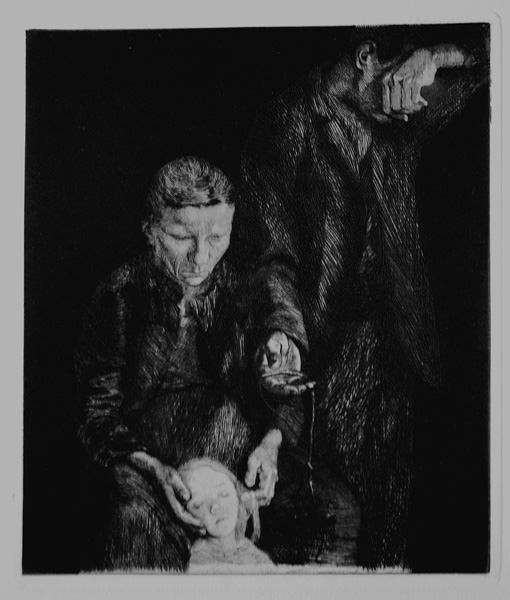 |
|
Zertretne / The Downtrodden–Poor Family (Kl. 48 IV. A. 2; von Knesebeck 49 bis II. B.b). Original etching, drypount, Aquatint, burnisher, 1900. This is the left section of a larger plate that Kollwitz cut into two parts before May, 1901 (for the other part of the original composition, click here). It is printed on China paper mounted on copperplate paper (chine collée); the paper size is 227x193mm; the platemark as mounted is 233x201mm. The image itself is rich, sharp, clear, and altogether as wonderful as the tragic scene—a father and mother mourning their dead daughter—allows. The sheet is annotated "Prof Kathe Kollwitz, Die Zertretne," an annotation presumably made before she was removed from her professorship at the Prussian Academy by the Nazis in 1933. From the quality of the impression, this appears to be an early proof and is rare in this condition. Price: Please call or email for current pricing information.
|
|
|
Spaightwood Galleries, Inc.
To purchase, call us at 1-800-809-3343 (1-508-529-2511 in Upton MA & vicinity) or send an email to spaighwood@gmail.com.
We accept AmericanExpress, DiscoverCard, MasterCard, and Visa.
We also accept wire transfers and paypal.
For directions and visiting information, please call. We are, of course, always available over the web and by telephone (see above for contact information). Click the following for links to past shows and artists. For a visual tour of the gallery, please click here. For information about Andy Weiner and Sonja Hansard-Weiner, please click here. For a list of special offers currently available, see Specials.
Go back to the top of this page.
Visiting hours: Saturday 10:00 am to 5:00 pm and Sunday noon to 6:00 pm and other times by arrangement.
Please call to confirm your visit. Browsers and guests are welcome.
|
|
|
|
|
|
|
|
|
|
|
|
|
|
|
|
|
|
|
|
|
|
|
|
|
|
|
|
|
|
|
|
|
|
|
|
|
|
|
|
|
|












